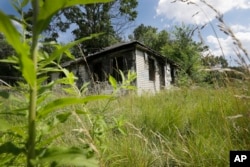Keith Green has an unusual fascination with vacant lots. Even on vacation.
Out for dinner in Shanghai one recent night, he came across a sight that stopped him short.
“Everyone else is taking pictures of the skyline,” he said. “I’m taking a picture of a vacant lot.”
Scourge of abandoned property
Abandoned properties don’t attract many tourists. In Green’s hometown of Philadelphia, vacant lots attract crime, from dumping trash, tires and broken appliances to stashing weapons and drugs.
Green is leading an effort to rid Philadelphia of these blights in low-income communities.
It’s a massive job. The city has an estimated 40,000 vacant lots.
But Green is witnessing how a little green space can make a big difference in urban areas plagued with poverty and crime.
Recent studies published in major scientific journals have documented how the program Green heads is helping drive substantial reductions in gun violence and depression in some of the poorest parts of Philadelphia.
Before the shooting starts
Gina South co-wrote those studies. She’s an emergency department physician at the University of Pennsylvania. Since her residency on the trauma unit, she has wanted to do more to help the people from these neighborhoods before they came to her on stretchers.
“We took care of a lot of shooting victims and did a great job of treating their physical injuries,” she said, “but did little to nothing to think about what was causing them to come in as shooting victims to us in the first place.”
Several years ago, South became interested in the program Green directs at the Pennsylvania Horticultural Society, called Philadelphia LandCare.
The program hires local landscapers to clear the trash and weeds from vacant lots, replace them with trees and grass, mow them twice a month, and surround them with fences with openings that invite people in.
Physical, emotional benefits
South said at first she was skeptical that it would do much for residents.
But the more she and her colleagues looked into it, the more positive results they found.
In one study, they found people’s heart rates declined as they walked past cleaned-up lots. That shows their stress levels are coming down, “a physiologic reaction happening in people’s bodies in response to what’s in their neighborhood environment,” she said.
Fighting crime with lawnmowers
The most significant results come from the group’s study of 541 vacant lots scattered across the city. They were divided into three groups. One got the full cleaning and greening treatment. One just got periodic trash pickups. One got nothing.
Around the cleaned and greened lots, crime declined by nearly 10 percent overall. In the poorest neighborhoods, gun crimes fell by 17 percent.
“Those are big effects,” said Northwestern University criminologist Wesley Skogan, who was not involved with the study.
Cleaning and greening vacant lots is “wiping out signs that nobody’s watching, nobody cares, nobody’s in charge,” he added.
It fits in with a concept called the “broken windows” theory. The idea is, disorder in the environment sends a signal that more disorder will be tolerated, including criminal behavior.
The theory became controversial as it evolved into “stop and frisk” policing, in which officers confront anyone they suspect may be up to no good.
Cleaning and greening “is much closer just to fixing the … window,” Skogan said.
South’s group also found that in the lowest-income neighborhoods, nearly 70 percent fewer people said they felt depressed.
It’s good for neighborhood morale, Skogan said. “It’s a sign that someone’s looking out for them. Someone’s paying attention.”
‘I didn’t think it would work’
The program is working better than even Green expected.
He had been doing community gardening with the Pennsylvania Horticultural Society as the LandCare program was getting started in the late 1990s and early 2000s.
“I was curious about the program. I didn’t think it would work,” he said.
At the time, he was planting flowers and shrubs and surrounding them with cyclone fences “to keep people out,” he said.
“This project was inviting people in. I was like, ‘That’s not going to work. People aren’t going to respect it.’”
“Then I started seeing people put picnic tables on it, putting garden areas in certain spots. They’re not destroying it,” he added. “Then I was like, ‘This can actually work.’ When I had the opportunity, I was all in.”
Green said each lot costs about $1,600 to treat and about $200 per year to maintain.
“It is a bargain,” South said.
However, Skogan would like to see research showing how it compares to other approaches.
“Probably nobody thought it was a bad idea to clean things up and put up fences,” he said. “It’s always a question of whether you do this versus something else. What this (research) says is, it’s not foolish.”
Green said he gets calls from officials across the country and the world asking how a little green space can help revive their neighborhoods.
He said he sees people’s mindsets changing in neighborhoods where he’s working. Kids don’t throw trash in the cleaned-up lots, he said. They pick it up.
That’s been satisfying enough, he said. “But when you start throwing (in) these numbers, like, gun violence is going down, and people’s heart rates are being reduced, people are exercising more in certain sections of Philadelphia, you’re just like, wow.”







